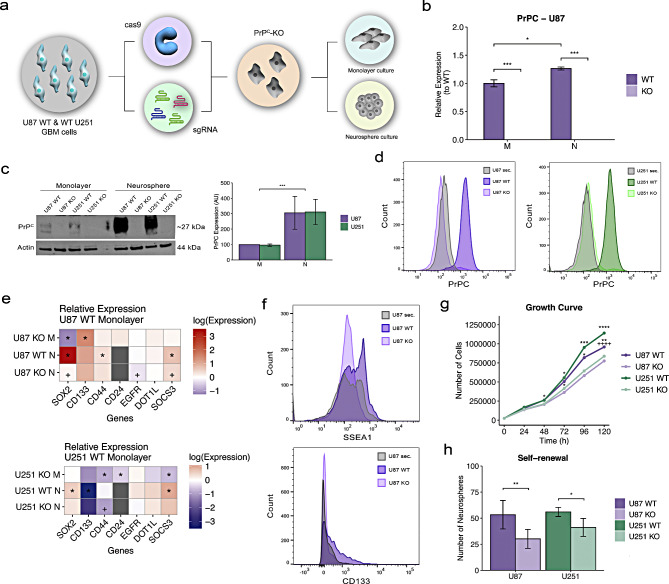Prion protein regulates invasiveness in glioblastoma stem cells.
BACKGROUND: Glioblastoma (GBM) is an aggressive brain tumor driven by glioblastoma stem cells (GSCs), which represent an appealing target for therapeutic interventions. The cellular prion protein (PrPC), a scaffold protein involved in diverse cellular processes, interacts with various membrane and extracellular matrix molecules, influencing tumor biology. Herein, we investigate the impact of PrPC expression on GBM. METHODS: To address this goal, we employed CRISPR-Cas9 technology to generate PrPC knockout (KO) glioblastoma cell lines, enabling detailed loss-of-function studies. Bulk RNA sequencing followed by differentially expressed gene and pathway enrichment analyses between U87 or U251 PrPC-wild-type (WT) cells and PrPC- nockout (KO) cells were used to identify pathways regulated by PrPC. Immunofluorescence assays were used to evaluate cellular morphology and protein distribution. For assessment of protein levels, Western blot and flow cytometry assays were employed. Transwell and growth curve assays were used to determine the impact of loss-of-PrPC in GBM invasiveness and proliferation, respectively. Single-cell RNA sequencing analysis of data from patient tumors from The Cancer Genome Atlas (TCGA) and the Broad Institute of Single-Cell Data Portal were used to evaluate the correspondence between our in vitro results and patient samples. RESULTS: Transcriptome analysis of PrPC-KO GBM cell lines revealed altered expression of genes associated with crucial tumor progression pathways, including migration, proliferation, and stemness. These findings were corroborated by assays that revealed impaired invasion, migration, proliferation, and self-renewal in PrPC-KO GBM cells, highlighting its critical role in sustaining tumor growth. Notably, loss-of-PrPC disrupted the expression and localization of key stemness markers, particularly CD44. Additionally, the modulation of PrPC levels through CD44 overexpression further emphasizes their regulatory role in these processes. CONCLUSIONS: These findings establish PrPC as a modulator of essential molecules on the cell surface of GSCs, highlighting its potential as a therapeutic target for GBM.
Authors
Prado MB, Coelho BP, Iglesia RP, Alves RN, Boccacino JM
External link
Publication Year
Publication Journal
Associeted Project
Systems Immunology of Human Diseases
Lista de serviços
-
Gene regulatory and signaling networks exhibit distinct topological distributions of motifs.Gene regulatory and signaling networks exhibit distinct topological distributions of motifs.
-
Gene signatures of autopsy lungs from obese patients with COVID-19.Gene signatures of autopsy lungs from obese patients with COVID-19.
-
Network Medicine: Methods and ApplicationsNetwork Medicine: Methods and Applications
-
ACE2 Expression Is Increased in the Lungs of Patients With Comorbidities Associated With Severe COVID-19.ACE2 Expression Is Increased in the Lungs of Patients With Comorbidities Associated With Severe COVID-19.
-
Drug repositioning for psychiatric and neurological disorders through a network medicine approach.Drug repositioning for psychiatric and neurological disorders through a network medicine approach.
-
Linking proteomic alterations in schizophrenia hippocampus to NMDAr hypofunction in human neurons and oligodendrocytes.Linking proteomic alterations in schizophrenia hippocampus to NMDAr hypofunction in human neurons and oligodendrocytes.
-
In-depth analysis of laboratory parameters reveals the interplay between sex, age, and systemic inflammation in individuals with COVID-19.In-depth analysis of laboratory parameters reveals the interplay between sex, age, and systemic inflammation in individuals with COVID-19.
-
The evolution of knowledge on genes associated with human diseasesThe evolution of knowledge on genes associated with human diseases
-
Network vaccinology.Network vaccinology.
-
Pyruvate kinase M2 mediates IL-17 signaling in keratinocytes driving psoriatic skin inflammationPyruvate kinase M2 mediates IL-17 signaling in keratinocytes driving psoriatic skin inflammation
-
Transcriptome analysis of six tissues obtained post-mortem from sepsis patientsTranscriptome analysis of six tissues obtained post-mortem from sepsis patients
-
Gene Signatures of Symptomatic and Asymptomatic Clinical-Immunological Profiles of Human Infection by Leishmania (L.) chagasi in Amazonian BrazilGene Signatures of Symptomatic and Asymptomatic Clinical-Immunological Profiles of Human Infection by Leishmania (L.) chagasi in Amazonian Brazil
-
In vitro morphological profiling of T cells predicts clinical response to natalizumab therapy in patients with multiple sclerosis.In vitro morphological profiling of T cells predicts clinical response to natalizumab therapy in patients with multiple sclerosis.
-
Integrative immunology identified interferome signatures in uveitis and systemic disease-associated uveitis.Integrative immunology identified interferome signatures in uveitis and systemic disease-associated uveitis.
-
Gene regulatory networks analysis for the discovery of prognostic genes in gliomas.Gene regulatory networks analysis for the discovery of prognostic genes in gliomas.
-
Revealing shared molecular drivers of brain metastases from distinct primary tumors.Revealing shared molecular drivers of brain metastases from distinct primary tumors.

